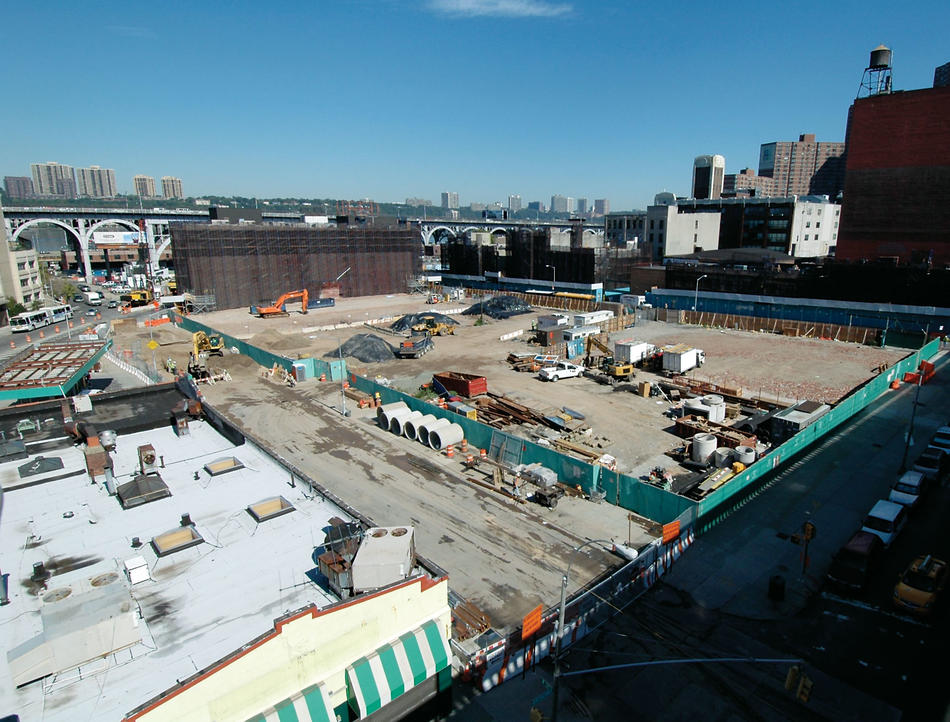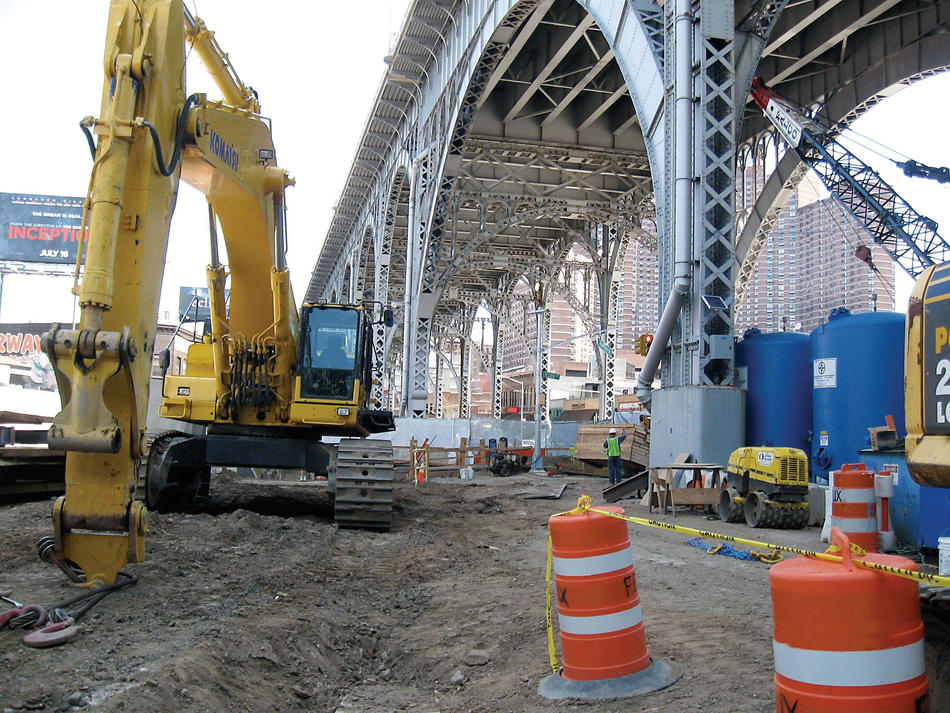A ruling by New York State’s highest court has cleared the way for Columbia to proceed with its long-term plans to develop the Manhattanville section of West Harlem. The Court of Appeals, in a unanimous decision on June 24, said that the state can invoke eminent domain to acquire properties that are crucial for the project. The court found that a state agency had acted lawfully two years ago when it concluded that Manhattanville is in need of redevelopment and that condemning property on behalf of Columbia would serve a public purpose.
Columbia, over the next several decades, plans to construct 16 buildings for science, business, the arts, University housing, and other uses on about 17 acres of land, located primarily on four blocks north of 129th Street on the far west side of Manhattan. The plan calls for a subterranean complex that will house central energy facilities, loading docks, parking, and other building support facilities, thus necessitating the development of contiguous properties. Columbia already owns most of the land in the expansion zone, which is an old manufacturing area dominated by warehouses, factories, and auto repair shops. In 2008, the Empire State Development Corporation (ESDC), the public authority that exercises the state’s power of eminent domain, determined that Columbia’s project would justify condemning property in the area should any landowners not sell.
However, two landowners, who own four warehouses and two gas stations in Manhattanville, sued the state to stop the condemnations. Last December, an appellate court sided with them. The lower court said that the state, in declaring the area “blighted,” and therefore in need of redevelopment, hadn’t considered the extent to which Columbia might have contributed to the blight itself by allowing some of its own properties in the area to lie dormant.
The new ruling refutes the idea that Columbia contributed to blight in Manhattanville. The Court of Appeals found that the lower court ignored evidence that the area has been physically rundown since at least the early 1960s, that there is a long-standing lack of investor interest in the area, and that Columbia had received few building violations on its properties in the expansion zone.
In addition, the Court of Appeals strongly affirmed the public benefits of Columbia’s development. “Indeed, the advancement of higher education is the quintessential example of a ‘civic purpose,’” wrote Judge Carmen Beauchamp Ciparick for the court. “It is fundamental that education and the expansion of knowledge are pivotal government interests. The indisputably public purpose of education is particularly vital for New York City and the State to maintain their respective statuses as global centers of higher education and academic research.”
The benefits of Columbia’s expansion, Ciparick asserted, are not limited to the advancement of higher education. She pointed out that the University will create more than two acres of publicly accessible open space, tree-lined and widened sidewalks, a revitalized shopping area along 12th Avenue, and a community space. She noted that Columbia will also supply land rent-free to a new public school in Manhattanville, maintain a recently completed waterfront park on the Hudson, create the equivalent of about 14,000 construction jobs over the course of the development, and add an estimated 6000 permanent jobs once the project completed.
“In sum, there can be no doubt that the project approved by ESDC — which provides for the expansion of Columbia’s educational facilities and countless public benefits to the surrounding neighborhood, including cultural, recreational, and job development benefits — qualifies as a ‘civic project,’” wrote Cipatrick.
Said President Lee C. Bollinger in a statement: “We are gratified by the Court’s unanimous decision, and we look forward to moving ahead with the long-term revitalization of these blocks in Manhattanville that will create thousands of good jobs for New Yorkers and help our city and state remain a global center of pioneering academic research.”
Going green
Construction in Manhattanville is expected to occur in phases over the next several decades. The first phase will include a neuroscience center and an underground central energy plant. The University also has plans to build here new homes for Columbia Business School and the School of International and Public Affairs, as well as new studio and arts presentation facilities for the School of the Arts.
Preparation work has already begun. Earlier this year, Columbia demolished several vacant buildings on plots that it owns between 129th and 130th Streets, west of Broadway. This will be the site of the Jerome L. Greene Science Center, which will serve as the home to the University’s expanding Mind, Brain, and Behavior Initiative. Neuroscientists will collaborate with researchers in fields ranging from economics to the arts in order to understand the causal relationships among gene function, brain wiring, and human behavior.
On a recent hard-hat tour, Philip Pitruzzello, Columbia’s vice president for the Manhattanville Development Group, under the University’s Facilities Department, said that contractors will begin work on the building’s foundation and slurry walls this winter. Construction of the Greene Science Center will take several years, he said, in part because this building, like many planned for Manhattanville, will benefit from a deep basement that maximizes its usable square footage. “We’ll start by excavating and creating a first slab,” Pitruzzello says. “Then we’ll dig down below that first slab at the same time that we’re building upwards. That’s called top-down construction, and it’s very innovative.”
In recent months, passersby will have noticed lots of street work in the area. Much of this is part of Columbia’s project: The University is paying for the upgrade, relocation, and separation of storm water and sewer water lines in the area, in anticipation of increased demand from its new facilities. “This is going to benefit northwestern Harlem,” says Pitruzzello.
All of Columbia’s new facilities in Manhattanville will be designed and built in accordance with strict standards of energy efficiency, according to Pitruzzello. The Greene Science Center, for example, will have interior spaces bathed in natural light, glazed windows that limit heat transfer, and a computer system that monitors the heating, ventilation, and lighting needs in specific areas of the building. (The U.S. Green Building Council has selected Columbia’s Manhattanville plan for its Leadership in Energy and Environmental Design for Neighborhood Development pilot program, which acknowledges the University’s commitment to green building principles and to creating a campus that is welcoming to the local community.)
Even Columbia’s demolition work aims for environmental sensitivity, says Pitruzzello. Many buildings are wrapped in netting as they’re gutted in order to capture debris and dust; diesel machines are fitted with special exhaust filters; and rodent specialists visit the sites regularly to make sure that rats aren’t being dislodged and fleeing. Most remarkably, the University has recycled or reused 90 percent of the materials from buildings torn down so far: Scrap steel, brick, and wood all have been recycled. In one building, local women and high-school students, as part of a training program, carefully removed wallboards, studs, doors, windows, cabinets, sinks, countertops, furniture, and lighting fixtures, all of which were then donated to a nonprofit that builds homes for disaster victims.
Columbia officials say they’re also committed to hiring a large number of businesses owned by minorities, women, and local entrepreneurs to do work in Manhattanville.
“Everything we do in Manhattanville is guided by our commitment to sustainability,” says Robert Kasdin, Columbia’s senior executive vice president. “From day one, it has informed all of our decisions. It was part of the master planning process and the design process, and now it’s part of every conversation we have with contractors when they come on site.”




